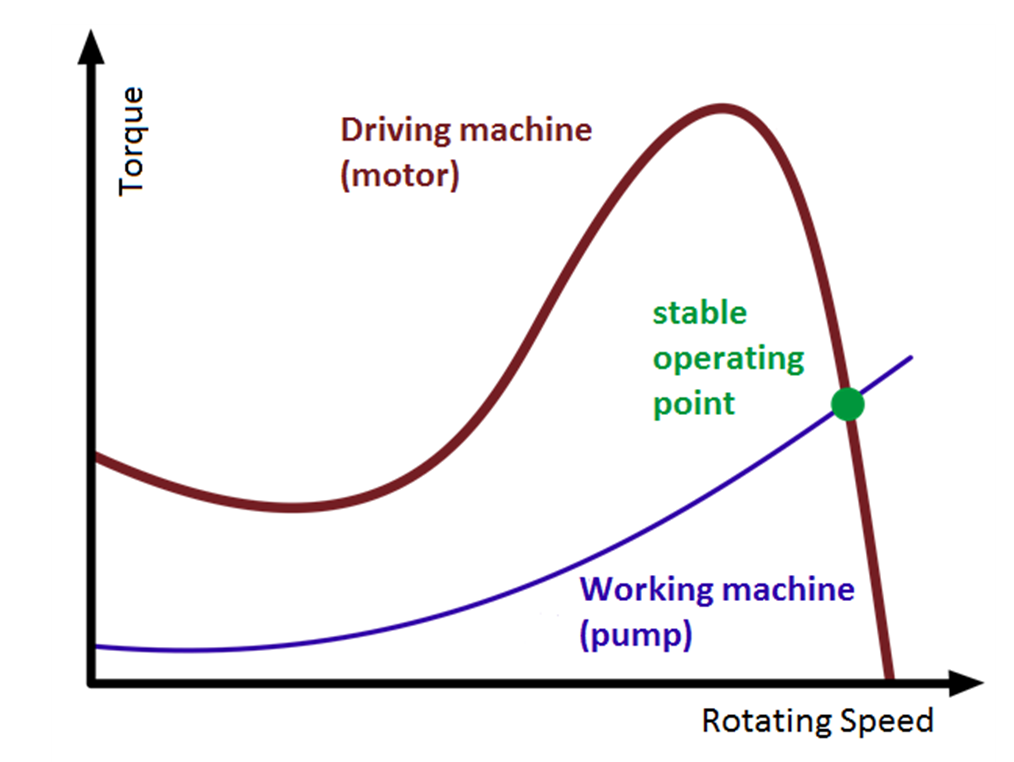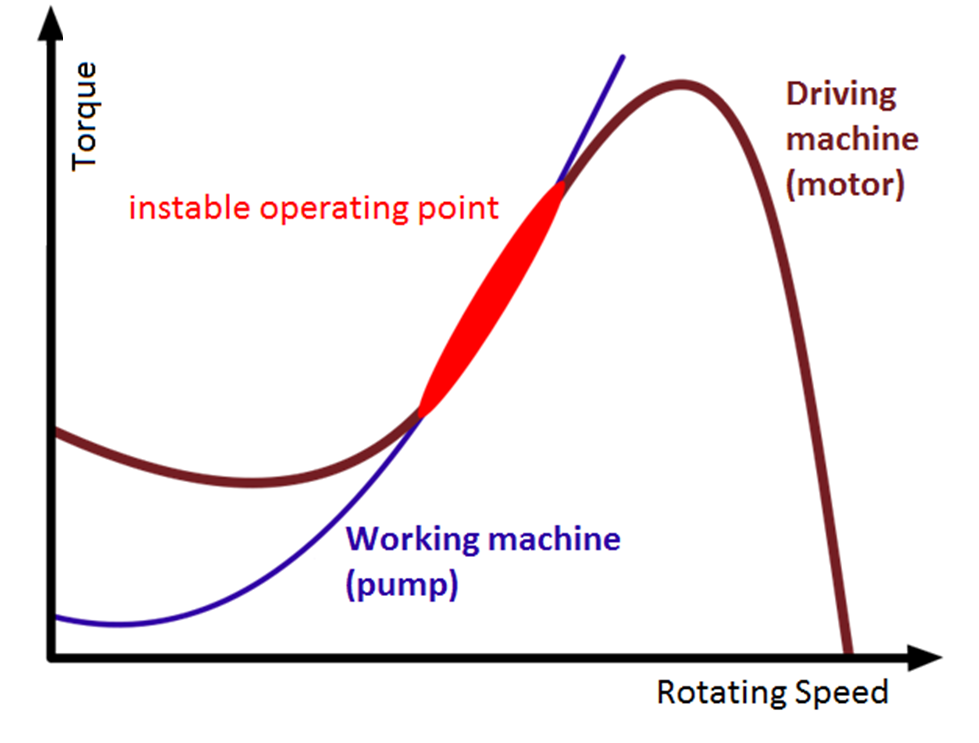operating point on:
[Wikipedia]
[Google]
[Amazon]
{{unreferenced, date=April 2013
The operating point is a specific point within the operation characteristic of a technical device. This point will be engaged because of the properties of the system and the outside influences and parameters. In
 The operating point of a system is the intersection point of the torque-speed curve of drive and machine. Both devices are linked with a shaft so the speed is always identical. The drive creates the torque which rotates both devices. The machine creates the counter-torque, e.g. by being a moved device which needs permanent energy or a wheel turning against the static friction of the track.
* The drive speed increases when the driving torque is higher than the counter-torque.
* The drive speed decreases when the counter-torque is higher than the driving torque.
At the operating point, the driving torque and the counter-torque are balanced, so the speed does not change anymore.
* A speed change in a stable operating point creates a torque change which acts against this change of speed.
A change in speed out of this stable operating point is only possible with a new control intervention. This can be changing the load of the machine or the power of the drive which both changes the torque because it is a change in the characteristic curves. The drive-machine system then runs to a new operating point with a different speed and a different balance of torques.
Should the drive torque be higher than the counter torque at any time then the system does not have an operating point. The result will be that the speed increases up to the idle speed or even until destruction. Should the counter torque be higher at any times the speed will decrease until the system stops.
The operating point of a system is the intersection point of the torque-speed curve of drive and machine. Both devices are linked with a shaft so the speed is always identical. The drive creates the torque which rotates both devices. The machine creates the counter-torque, e.g. by being a moved device which needs permanent energy or a wheel turning against the static friction of the track.
* The drive speed increases when the driving torque is higher than the counter-torque.
* The drive speed decreases when the counter-torque is higher than the driving torque.
At the operating point, the driving torque and the counter-torque are balanced, so the speed does not change anymore.
* A speed change in a stable operating point creates a torque change which acts against this change of speed.
A change in speed out of this stable operating point is only possible with a new control intervention. This can be changing the load of the machine or the power of the drive which both changes the torque because it is a change in the characteristic curves. The drive-machine system then runs to a new operating point with a different speed and a different balance of torques.
Should the drive torque be higher than the counter torque at any time then the system does not have an operating point. The result will be that the speed increases up to the idle speed or even until destruction. Should the counter torque be higher at any times the speed will decrease until the system stops.
 Also in case of an unstable operating point the law of the balance of the torques is always valid. But when the operating point is unstable then the characteristics of drive and machine are nearly parallel. In such a case a small change in torque will result in a big change of speed. In practice no device has a characteristics which is so thin that the intersection point can be clearly expected. Because of parallel characteristics, inner and outer friction as well as mechanical imperfections the unstable operating point is rather a band of possible operating states ins
Also in case of an unstable operating point the law of the balance of the torques is always valid. But when the operating point is unstable then the characteristics of drive and machine are nearly parallel. In such a case a small change in torque will result in a big change of speed. In practice no device has a characteristics which is so thin that the intersection point can be clearly expected. Because of parallel characteristics, inner and outer friction as well as mechanical imperfections the unstable operating point is rather a band of possible operating states ins
electronic engineering
Electronics engineering is a sub-discipline of electrical engineering which emerged in the early 20th century and is distinguished by the additional use of active components such as semiconductor devices to amplify and control electric current ...
establishing an operating point is called biasing
In electronics, biasing is the setting of DC (direct current) operating conditions (current and voltage) of an active device in an amplifier. Many electronic devices, such as diodes, transistors and vacuum tubes, whose function is processin ...
.
Wanted and unwanted operating points of a system
 The operating point of a system is the intersection point of the torque-speed curve of drive and machine. Both devices are linked with a shaft so the speed is always identical. The drive creates the torque which rotates both devices. The machine creates the counter-torque, e.g. by being a moved device which needs permanent energy or a wheel turning against the static friction of the track.
* The drive speed increases when the driving torque is higher than the counter-torque.
* The drive speed decreases when the counter-torque is higher than the driving torque.
At the operating point, the driving torque and the counter-torque are balanced, so the speed does not change anymore.
* A speed change in a stable operating point creates a torque change which acts against this change of speed.
A change in speed out of this stable operating point is only possible with a new control intervention. This can be changing the load of the machine or the power of the drive which both changes the torque because it is a change in the characteristic curves. The drive-machine system then runs to a new operating point with a different speed and a different balance of torques.
Should the drive torque be higher than the counter torque at any time then the system does not have an operating point. The result will be that the speed increases up to the idle speed or even until destruction. Should the counter torque be higher at any times the speed will decrease until the system stops.
The operating point of a system is the intersection point of the torque-speed curve of drive and machine. Both devices are linked with a shaft so the speed is always identical. The drive creates the torque which rotates both devices. The machine creates the counter-torque, e.g. by being a moved device which needs permanent energy or a wheel turning against the static friction of the track.
* The drive speed increases when the driving torque is higher than the counter-torque.
* The drive speed decreases when the counter-torque is higher than the driving torque.
At the operating point, the driving torque and the counter-torque are balanced, so the speed does not change anymore.
* A speed change in a stable operating point creates a torque change which acts against this change of speed.
A change in speed out of this stable operating point is only possible with a new control intervention. This can be changing the load of the machine or the power of the drive which both changes the torque because it is a change in the characteristic curves. The drive-machine system then runs to a new operating point with a different speed and a different balance of torques.
Should the drive torque be higher than the counter torque at any time then the system does not have an operating point. The result will be that the speed increases up to the idle speed or even until destruction. Should the counter torque be higher at any times the speed will decrease until the system stops.
Stable and unstable operating points
 Also in case of an unstable operating point the law of the balance of the torques is always valid. But when the operating point is unstable then the characteristics of drive and machine are nearly parallel. In such a case a small change in torque will result in a big change of speed. In practice no device has a characteristics which is so thin that the intersection point can be clearly expected. Because of parallel characteristics, inner and outer friction as well as mechanical imperfections the unstable operating point is rather a band of possible operating states ins
Also in case of an unstable operating point the law of the balance of the torques is always valid. But when the operating point is unstable then the characteristics of drive and machine are nearly parallel. In such a case a small change in torque will result in a big change of speed. In practice no device has a characteristics which is so thin that the intersection point can be clearly expected. Because of parallel characteristics, inner and outer friction as well as mechanical imperfections the unstable operating point is rather a band of possible operating states ins